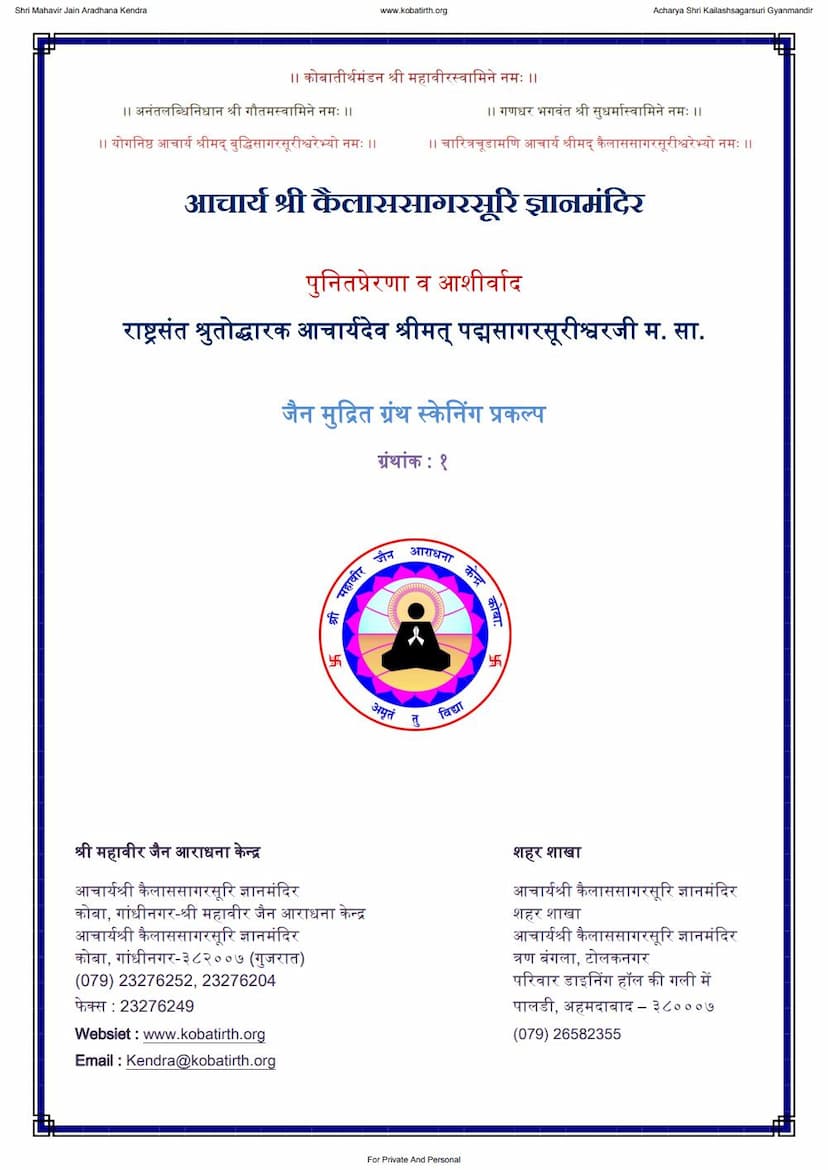Navtattva
Added to library: September 2, 2025

Summary
This Jain text, titled "Navtattva" (Nine Principles), published by Atmanand Jain Pustak Pracharak Mandal, provides a detailed exposition of the fundamental philosophical categories in Jainism. The book, translated into Hindi with its original Sanskrit verses, aims to propagate Jain literature in the national language.
The core of the text lies in the systematic explanation of the nine tattvas (principles):
-
Jiva (Soul): Defined by consciousness, the soul is the living entity. The book elaborates on its various classifications based on senses (ekendriya to panchendriya), modes of existence (tras and sthavara), gender (viveda), and rebirth destinations (gatis). It also details the soul's characteristics like knowledge, perception, conduct, penance, energy, and usage. The concept of Paryapti (fulfillment of capacities) and Prana (life-force) are also explained in relation to the soul.
-
Ajiva (Non-soul): This category encompasses inanimate substances. The text explains the five Ajiva categories: Dharmastikaya (principle of motion), Adharmastikaya (principle of rest), Akashastikaya (space), Pudgalastikaya (matter), and Kala (time). Their natures, divisions (like skandha, desha, pradesha, paramanu), and functions are described. The interdependence of these substances and their role in the universe are also touched upon.
-
Punya (Merit): Actions and karmas that lead to happiness and pleasant experiences are classified as Punya. The book lists 42 types of Punya, often associated with good qualities, virtuous actions, and favorable karmic consequences, leading to a better rebirth and experience in life.
-
Papa (Demerit): Actions and karmas that result in suffering and unpleasant experiences are classified as Papa. The text enumerates 82 types of Papa, associated with vices, negative actions, and unfavorable karmic consequences.
-
Asrava (Influx): This refers to the influx of karmic particles into the soul due to the activities of senses, passions, and activities of mind, speech, and body. The text identifies 42 types of Asrava, stemming from the functioning of the five senses, four passions (kashayas), five vows (avratas), three types of activities (yoga), and 25 specific actions (kriyas).
-
Samvara (Stoppage): This is the principle of checking the influx of new karmas. The book details 57 types of Samvara, achieved through practices like the five restraints (samitis), three controls (guptis), endurance of 22 types of hardships (parishahas), ten virtues of ascetics (yati-dharma), twelve contemplations (bhavanas), and five types of conduct (charitras).
-
Nirjara (Shedding of Karma): This involves the shedding or destruction of already accumulated karmas. The text outlines twelve types of Nirjara, categorized into six external austerities (bahya tapas) and six internal austerities (abhyantara tapas). These practices aim to purify the soul by eliminating karmic obstructions.
-
Bandha (Bondage): This is the process by which karmic matter binds to the soul. The book explains the four types of Bandha: Prakriti Bandha (nature of karma), Sthiti Bandha (duration of karma), Anubhaga Bandha (intensity of karma's effect), and Pradesha Bandha (quantity of karmic particles). The text also details the eight types of karmas (Jnanavaraniya, Darshanavaraniya, Vedaniya, Mohaniya, Ayushya, Nama, Gotra, Antaraya) and their sub-categories.
-
Moksha (Liberation): This is the ultimate goal of Jainism, the complete liberation of the soul from all karmic bondage. The text describes Moksha through various "gates" or aspects, including the nature of the liberated soul (Siddha), their quantity, the realm they inhabit, and the process of achieving liberation. It explains that liberation is achieved through the highest conduct (Yathakhyata Charitra) and the complete eradication of passions and karmas.
The book also includes detailed explanations of the classifications within each tattva, often supported by verses from Jain scriptures. It emphasizes the importance of understanding these principles for achieving right faith (Samyaktva) and ultimately liberation. The text also provides biographical information about patrons and contributors, highlighting their devotion and support for the propagation of Jain literature.